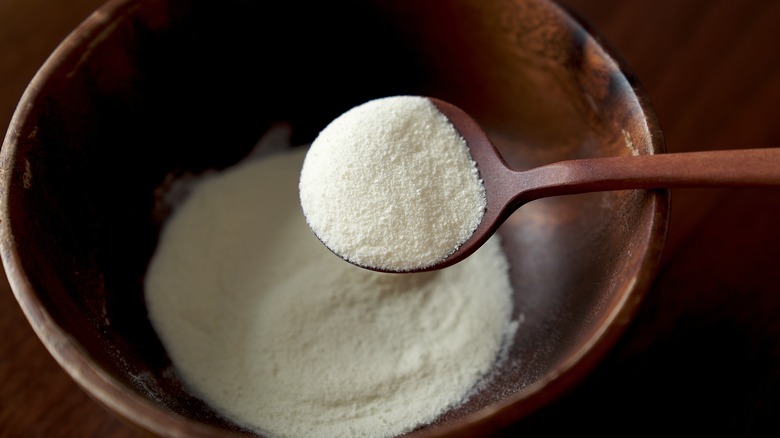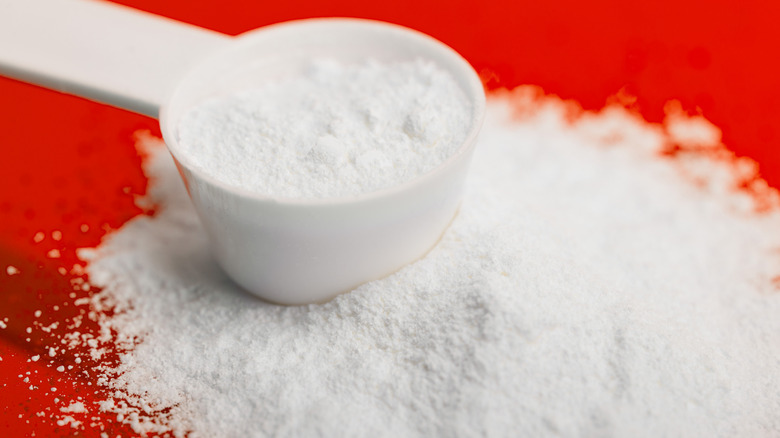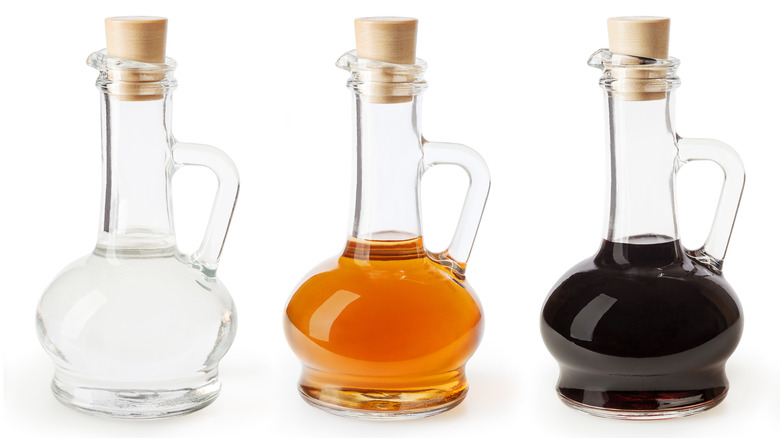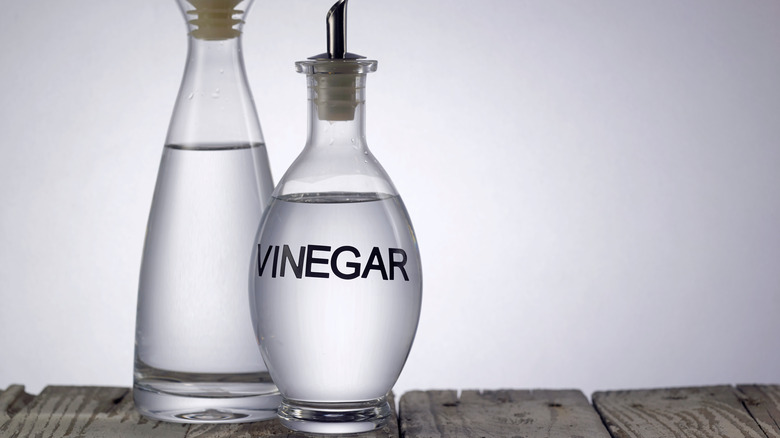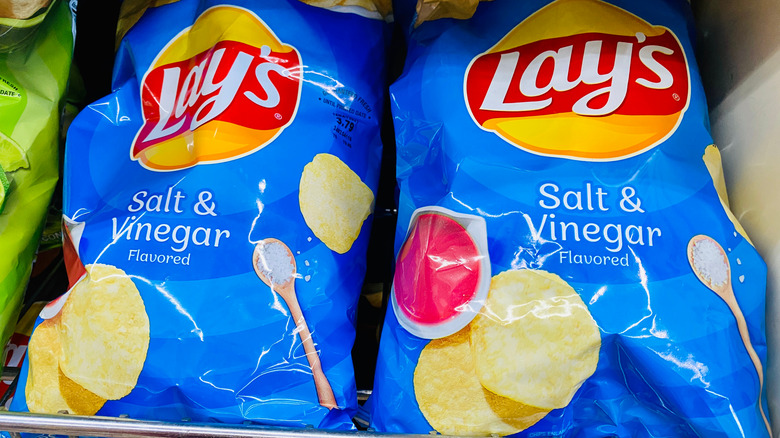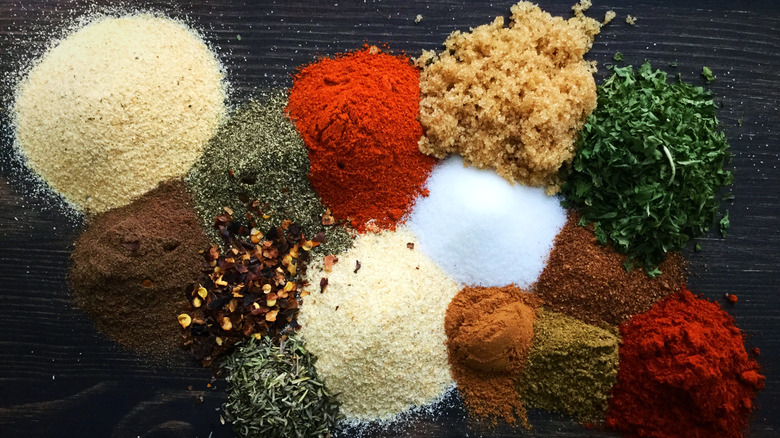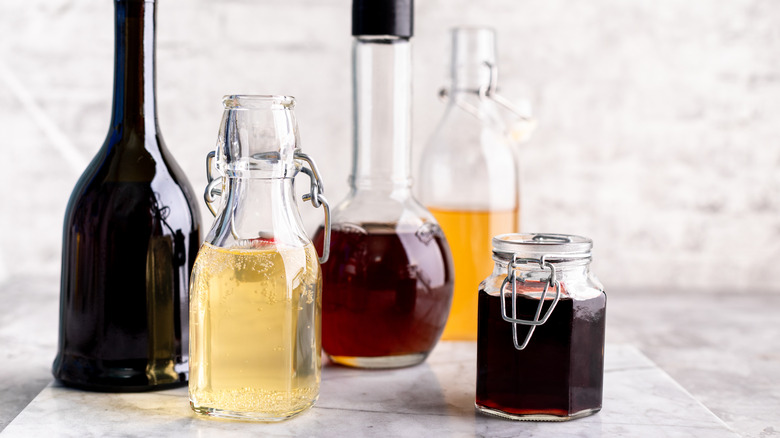Vinegar Powder Is The Overlooked Ingredient Your Pantry Is Missing
We may receive a commission on purchases made from links.
Everyone knows that vinegar is an acidic staple ingredient that resides in most household pantries, adding the perfect tangy base to many vinaigrettes, sauces, and pickling liquids. However, it's commonly known to be in liquid form. Prepare to be amazed, as you can actually purchase it as a powder. That's right, vinegar powder is a real thing, and it's been around for longer than you think.
Dating back to the early 1600s, there's a recipe on how to make powdered vinegar in a book called "The English Housewife," by Gervase Markham. The substance was not only used for incorporation into recipes back in the day but also to aid in sickness. Sometime between the late 1960s and early 1970s, the recipe was tweaked to manufacture the powder much more easily and efficiently, and it has since become a big component in kitchens.
What is vinegar powder?
Before we get into the nitty-gritty of the unique ingredient that is vinegar powder, let's break down what vinegar is exactly. Not many pantry ingredients can act as a flavorful addition to your dinner, while also as a food preservative, natural medicine, and cleaning solution all in one. Believe it or not, it's actually just wine that's gone sour.
While wine is already a fermented liquid, when left out for too long, it ferments even more to produce this highly acidic substance. This may sound alarming, but when undergoing a specific process, it's completely safe. Basically, vinegar is first alcohol, and that alcohol is presented with oxygen and Acetobacter, a bacteria known as acetic acid, which then ferments for another few months to reach the proper level of acidity.
Vinegar powder is essentially vinegar introduced with starch to dehydrate into a dry substance, with the starch being maltodextrin. Seeing that vinegar has so many uses, vinegar powder serves the exact same purposes.
How is vinegar powder made?
The original recipe of vinegar powder was essentially liquid vinegar being introduced to starch, which then absorbed the liquid and was converted into a powdery substance. When the recipe was tweaked during the late 1900s, the original starch was changed.
Maltodextrin, which is a permeable starch, was discovered and was found to be a more successful way to turn a liquid into a solid. Furthermore, because it's porous and permeable, it has a better chance of taking on the flavor of the liquid it's marrying, compared to just tasting like plain 'ol starch.
Nowadays, whether you're purchasing vinegar powder or making it yourself, it is generally produced by misting any type of vinegar you prefer onto maltodextrin and letting it sit. This allows the starch's particles to absorb all that pungent flavor.
While starches help in terms of soaking up liquid and taking on flavor, dehydrating is another method. The thing is, it takes a lot more time. It essentially involves reducing vinegar and baking soda in a pot until it has reached less than half of its original volume, then transferring it to a dehydrator for several hours. Once the liquid turns to chunky bits, you'll pulse it in the food processor or blend it until a powder forms, adding in maltodextrin if needed to fully get rid of any residual liquid.
Powder vs. liquid
While liquid vinegar often gets the job done and is the perfect component to a vinaigrette or pickling liquid, if you're ever in a situation where a dry rub or seasoning you're using is missing a tangy component to it, vinegar powder works like a charm. In fact, this is how salt and vinegar chips get that tongue-curling vinegar flavor without sacrificing the crispy texture of potato chips. Using liquid vinegar would make the chips soggy and cause them to lose their crunch.
Furthermore, when you're working with a sauce, salad dressing, or dip, and the consistency is right where you want it before you've added the vinegar in, in order to keep the texture at the perfect thickness, vinegar powder is the optimal add-in. It provides that punch without causing your recipe to turn runny.
Aside from the fact that vinegar powder helps keep certain foods at the ideal consistency without thinning it out too much, there is also a variety that is meant for food preservation with the sour taste completely removed, known as concentrated vinegar powder. While liquid vinegar helps with preserving food as well, when working with this type of powder, you're using an all-natural preservative that won't alter the taste of the foods you're trying to keep fresh.
What does vinegar powder taste like?
If you guessed that vinegar powder tastes like vinegar, you're correct! However, with the taste of vinegar comes the texture, and it's hard to mimic the same flavor in a different form. If you've ever had salt and vinegar chips, that's the perfect depiction of this unique ingredient, sans the salt. Vinegar powder is tangy and tart, and likely needs some other spices in the mix to balance out the pungency it provides.
There are different types of vinegar powder, depending on the type of vinegar that was used to make it, and also the purpose it serves. If you're working with a balsamic vinegar powder, it will likely be on the sweeter side. If you're incorporating a white vinegar powder, chances are it will be much more tart. Concentrated vinegar powder is the polar opposite, with much less of a tart taste in order to preserve the foods without changing their flavors. Therefore, the goal of concentrated vinegar powder is to not have a taste at all.
How to use vinegar powder
When wondering how to incorporate vinegar powder into everyday dishes, it's as easy as simply sprinkling it into your favorite things that need a touch of tang. Whether you're blending a sauce, whisking a vinaigrette, massaging meat into a marinade, serving up a dip, or even stirring up a seasoning blend, a touch of vinegar powder can take your next meal from good to great.
However, proceed with caution, as a little bit goes a long way. Some other fun ways to use it are by mixing it with some salt and tossing your popcorn, french fries, or potato chips in it. This will give you a salt-and-vinegar flavor profile that you crafted right at home.
Vinegar powder has a wonderful way of preserving foods, as it contains the same antimicrobial makeup that liquid vinegar does. The less tangy stuff, concentrated vinegar powder, can be used to coat meat, cheeses, fruit, veggies, or other perishable foods that need their freshness prolonged.
Where to buy vinegar powder
Regular vinegar powder used for seasonings and flavoring foods is readily available at most large, well-known grocery stores. However, concentrated vinegar powder, which is meant to act as a food preservative, is a bit tougher to find in person. To ease the trouble, you can easily find both types on Amazon and get them delivered to your doorstep.
If you're not able to find vinegar powder anywhere near you, you're in luck as it's easy to make it yourself with the help of two handy dandy ingredients: liquid vinegar and maltodextrin. Vinegar is readily available just about anywhere, and maltodextrin can be found in-store or online at Walmart and Amazon.
If you're not able to find the proper ingredients, dehydrating is an option that uses two very common ingredients: liquid vinegar and baking soda. Check out this YouTube video on how to do it step by step.
Nutritional information about vinegar powder
When it comes to vinegar powder and the high amounts of maltodextrin within, it's easy to wonder if it proposes health risks. Fortunately, maltodextrin contains zero calories, fat, and cholesterol. Furthermore, because it is considered a starch, you'd assume it contains a certain amount of carbs, but it actually has too little for your body to recognize upon digestion, considering not that much goes into a single serving of seasoning. However, the carbs that it does contain are complex carbohydrates, which means that they won't cause an abrupt incline in blood sugar. This is beneficial for those with diabetes or trying to prevent its onset.
Therefore, maltodextrin is extremely safe and is actually a lot more beneficial for preserving food compared to other products commonly used, such as benzoates and sorbates, which have historically been linked to health problems.
Most kinds of vinegar are extremely low in calories, sodium, and sugars, with balsamic being the highest. However, vinegar powders are typically made using white distilled, malt, or apple cider vinegar. For those on restrictive diets, vinegar powder is a wonderful way to spruce up a meal without exceeding your macros.
Other varieties of vinegar powder
Because vinegar is derived from alcohol, and alcohol is essentially a plant-based ingredient that has undergone a fermentation process, the different flavors of vinegar indicate what ingredient was originally used for fermentation.
For instance, balsamic vinegar is made from compressed red grapes, white distilled vinegar is made from different types of starches such as whole grains and potatoes, malt vinegar is made from beer, and the more obvious ones are rice vinegar being made from rice, red wine vinegar being made from red wine, and apple cider vinegar consisting of pressed apples. This gives each vinegar a different flavor, which translates into vinegar powders that you can buy or make yourself.
The most common types of vinegar powder with intentions for consumption include white distilled, malt, and apple cider. Concentrated vinegar powder is a variety that is made for the purpose of food preservation.
